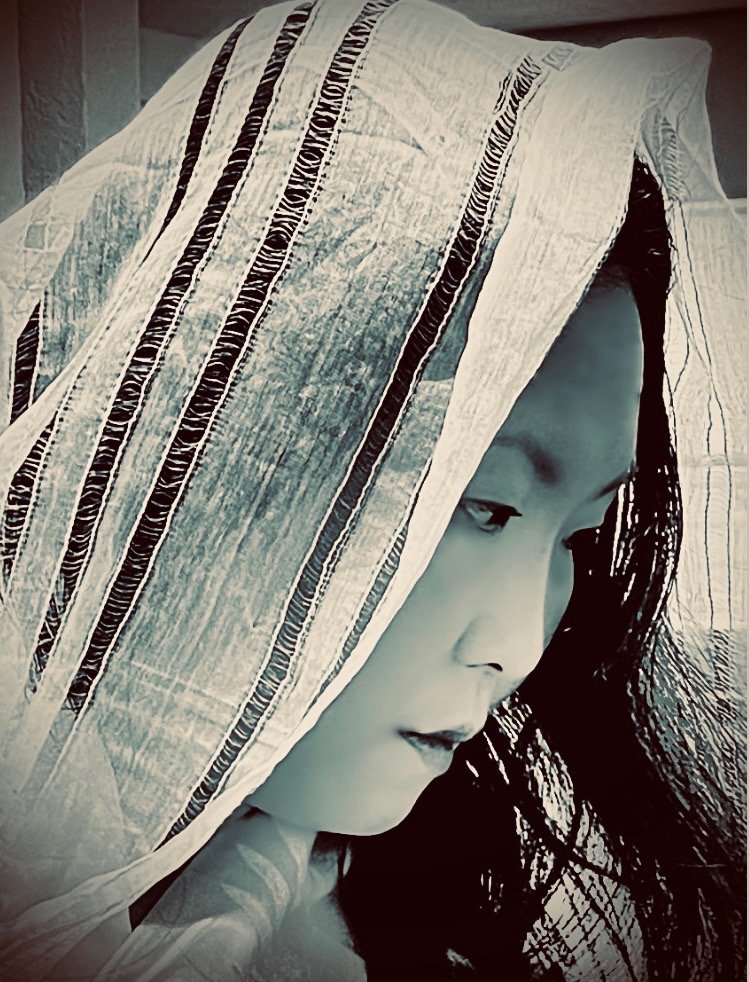OPERA YUKIONNA
Written and Composed by Asako Hirabayashi
Based on a well known and ancient Japanese folktale, this opera re-imagines the heart-wrenching tragedy of the Snow Witch, Yukionna — a story of a love torn between human desire, and the brutal instincts of Mother Nature. This ancient folktale is brought to life as it blends both Japanese and Western cultures, by blending Western opera style with Japanese arias and musicality. Legend has it that the Snow Witch, the spirit of winter incarnate, is the ghost of a woman who perished in a snowstorm. Although she appears as beautiful as winter snow, her ephemeral beauty masks her ruthlessness. There is no single story of Yukionna, with the oldest tale dating as far back as 1737. Asako wove her own experiences as a mother of two (one has multiple disabilities and one is adopted) together with ideas about Mother Nature, natural disasters, discrimination, death, life, love, trust, sacrifice and cultural elements such as Japanese aesthetics, and virtues.
Creator/Librettist/Composer : Asako Hirabayashi, Dramaturg: Steven Epp, Lyrics: Japanese, Dialogue: English
Development
Workshop :2014 Nautilus Music-Theater (2012 Jerome Fund for New Music
Reading concert : 2015 Nautilus Music-Theater hosted by Japan America Society of Minnesota (2013 Minnesota State Arts Board by lead soprano Momoko Tanno, Metropolitan Regional Art Council, Consulate General of Japan)
Instrumentation
Full Orchestra or Chamber version (flute, oboe, clarinet, bass clarinet, bassoon, 2 violins, viola, cello, double bass, 2 percussions , piano)
Duration 85 mintes
Cast: Oyuki (Yukionna) : soprano, Minokichi : tenor, Mosaku : baritone, Daimyo : bass, Haruko : soprano, Akiko : mezzo soprano, Sumiko : alt, Villager 1 :tenor, Villager 2 : bass, (Choir)
Synopsis
In a small village there lived two woodcutters, a father Mosaku and a son Minokichi. One very cold evening, they took shelter in a cabin in the mountain. Yukionna (Snow witch) appeared and blew her breath upon Mosaku. Instantly he froze to death. Minokichi was horrified, but was also stunned and mystified by her incredible beauty. She was also attracted to Minokichi, and let him go on one condition - not ever tell anybody about her and what happened that night. He promised never tell anybody. A year has passed, Minokichi met a beautiful woman Oyuki. They got married and started a family. One snowy night, Minokichi suddenly remembered the night which his father was killed. He broke a promise, told Oyuki about the night his father was killed by Yukionna. Oyuki revealed the secret - she is the Yukionna disguised as a human……
Testimonial
Harukaze: the World Premiere of Yukionna Welcomes a Sold-Out House
The world premiere of Asako Hirabayashi’s Yukionna took place at JASM’s annual spring event, Harukaze, on Sunday, May 31st, 2015. Attendance exceeded expectations with the event packing Hamline University’s Sundin Music Hall to full capacity! Every seat was filled—even standing-room only attendees enjoyed the show. With minimal costumes and stage décor, the performers utilized their immense musical talent to paint vivid pictures of the heartbreaking love story of Oyuki (Momoko Tanno) and Mosaku (Shahzore Shah).
Audience members were riveted as they took in the story of Yukionna—only able to tear their gaze away from the performers to dry their tearful eyes due to the emotive performance. Recalling the event, the haunting and beautiful sounds of the final act, Sayonara (Farewell), still ring in their ears. The performance was truly outstanding and absolutely unforgettable.
When the final notes resonated throughout the auditorium, the show ended with a standing ovation—praise well deserved for all of the artists’ hard work. As guests filed out of the auditorium, they gushed with praise at this outstanding multicultural performance. One commented, “I have never seen an opera like this before…it was extremely unique...and the music was incredible!” Another attendee wrote to express his gratitude: “The score was complex, exciting, interesting, and beautifully performed! All in all...a treat to the ears, mind, and soul!” Thank you to Asako Hirabayashi for creating this fine work of art, to the talented musicians for sharing their gifts with us, to all of our sponsors for making this event possible, to Tomoko Drake and friends for providing the delicious tea and cakes for the reception, and to the attendees for sharing this unforgettable moment with us.
June/2015 JASM news letter
Dramaturg writer, Steven Epp
Steven Epp is an actor and writer based in Minneapolis. Steven was a co-Artistic Director of Theatre de la Jeune Lune, 1983-2008, winner of the 2005 Tony award for Best Regional Theatre.
Opera Hebionna
Written and Composed by Asako Hirabayashi
Original story, libretto and music by award-winning composer Asako Hirabayashi, Hebionna (Snake Woman) infuses Japanese culture, language and traditional instrument Shamisen. The story is about the beauty of diversity, unconditional love, benevolence, and how human beings coexist as part of mother earth, despite the shadow side of human nature that leads to violence, discrimination and segregation.
Creator/Librettist/Composer : Asako Hirabayashi, Dramaturg : Ben Krywosz, Lyrics: Japanese, Dialogue: English
Development :
Workshop: 2019 (2018 Minnesota States Arts Board Artist Initiative Grant by lead soprano, MomokoTanno)
Reading Concert: 7pm, June 27th 2022 at University of North Carolina Charlotte Rowe Recital Hall ,hosted by Charlotte New Music and University of North Carolina Charlotte
funded by 2019 Schubert Club Composer Award, 2021 Opera America Discovery Grant), the Digital Arts Studio in the College of Arts and Architecture at UNC Charlotte
Chamber Opera - Shamisen, Violin, Cello, Piano
Duration 70 minutes
Cast:
Soprano: Miko (Snake Woman) - Momoko Niemi Tanno
Tenor: Yoshizo (Wood cutter) - Brian Arreola
Boy Soprano: Ryu (Son fo Miko and Yoshizo) - Leilani Arreola
Soprano: Michiko (villager) - Chrystle Villaflor
Alto: Nobuko (Villager) - Frida Sophia Chacon Marmolejos
Tenor: Sennosuke (Villager) Christian Souza
Bass: Gonzo (The head of villager) Zach Voigt
Instruments:
Shamisen: Momokusu Iwata
Violin : Kari Giles
Cello : Mira Frisch
Piano : Tomoko Deguchi
Lighting and Scenic Designer: Matthew Fergen
Videographer: Max Kusmyak
Synopsis
A countryman saves a snake caught in a trap. The snake, disguised as a woman, shows her gratitude to him. They fall in love, get married and start a family. However, when the villagers find out the man had a snake as a wife and have a child together, disgusted and angry, they kill the family. It is a tragedy, but the story eventually ends with an ultimate healing for both sides. It reminds us of the lessons to be learned from the natural world, that even animals know how to be grateful, how to repay their debts and how to love their families. We humans can learn from their pure compassion and sacrifice. We find ourselves in a cruel world divided by greed and prejudice. It is a good time to reconnect with our authentic selves, with our natural roots of pure goodness. The story also reminds us how important it is for human beings to coexist with nature. The story ends tragically, as humans kill one another and destroy nature, but nature never seeks revenge, but nurtures us.
Testimonial
“I enjoyed your opera very much. I appreciated learning the Hebionna (Snake Woman) folklore through your beautiful composition in a setting that combined the beautiful sounds of the Japanese language with a wonderfully played Shamisen. I was impressed by your ability to address important societal issues such as diversity, segregation, fear of the "other," and the power of benevolence and unconditional love all within a very pleasing and mellifluous composition. Congratulations on a work that fosters an understanding of the fragile nature of our necessary interdependence with one another and with nature. Your opera has much to teach us and I wish you luck with future performances. I am honored that we could host the premiere at the University of North Carolina at Charlotte and remain grateful for all of the talents your production brought to our community.” Joe Skillen
“The pacing of the narrative and its corresponding music are very effective. While I am not knowledgeable in Japanese theatre, it feels like you combine western opera elements with Eastern aesthetics, and it tells the story very well. One of the most delightful aspects of your opera comes from the fact that you tell large parts of the story without any text. This is crucial in moving along a narrative. I felt the austere "dankness" of the (very effective and idiomatic) piano solo only to later find out it was called "The Swamp." Tomoko told me this. You nailed it!” Mark Lewis
Opera The Boy Who Drew Cats
Written and Composed by Asako Hirabayashi
Creator/Librettist/Composer : Asako Hirabayashi, Lyrics: Japanese, Dialogue: English
Based on the ancient Japanese folktale, rewritten by Asako Hirabayashi, the story is about children’s shortcoming can be a power and strength for their success in their lives.
From Composer:
I have a disability called selective mutism and could not talk at all outside of my house when I was young. Nobody in my family was a musician, but my mother took me to a music school because she thought I could enjoy doing something alone. If I don’t have a disability, I would not have been introduced to instruments and would have never become a musician. As a mother, I raised a daughter who has significant disabilities. However, raising her changed me and people around her for the better. She taught me love, acceptance, empathy, strength and tenacity and saved me from the hell of perfection, insecurity, self pity and low self-esteem. In this world, there are many people who suffer from numerous physical challenges or illnesses, but I realized that by influencing others around them, those people are the ones who can teach us the most important things about the most beautiful parts of life, about helping each other. I realized that it’s not about people who are powerful or important, but rather that it’s the weak people who have the power to truly change society, by making those around them better human beings.
Development :
Workshop/reading concert: 3pm, June 11th 2023 at Sundin Hall, Hamline University in St.Paul. 2023 hosted by Japan America Society of Minnesota,
funded by 2023 Minnesota States Arts Board Creative Support Grant)
Chamber Opera - Violin, Cello, Piano
Duration 45 minutes
Cast:
Tenor: Kotaro (Son of farmer) - Brian Arreola
Baritone; Sasuke (farmer) - Kelvin Chan
Tenor: Kyonosuke (Villager)Timothy P. Faatz
Baritone: Kasuke (Villager) - Sullivan Ojala Helmbolt
Bass: Gorou/Rat (Villager/Rat) - Justin Staebell
Narator: Momoko Tanno
Instruments:
Violin : Daria Adams
Cello : Mira Frisch
Piano : Ivan Konev
Lighting and Scenic Designer: Mayumi Amada
Videographer: Max Kusmyak
Synopsis
Synopsis: In a rural village a farmer, Sasuke, was raising his son Kotaro by himself, worrying about his future since he was introverted and only interested in drawing cats on the wall. After a heated argument, Kotaro left Sasuke. Wandering around in the village, he found an abandoned temple and decided to stay the night. Kotaro drew a lot of cats on the wall as usual. A monstrous rat appeared in the middle of the night and threatened to kill Kotaro. Wondrously, the cats which he drew came to life and fought the terrible rat. Kotaro learned that the temple was abandoned because of this horrible rodent. The story of the amazing paintings by Kotaro spread quickly bringing him fame and making him become a famous painter.



